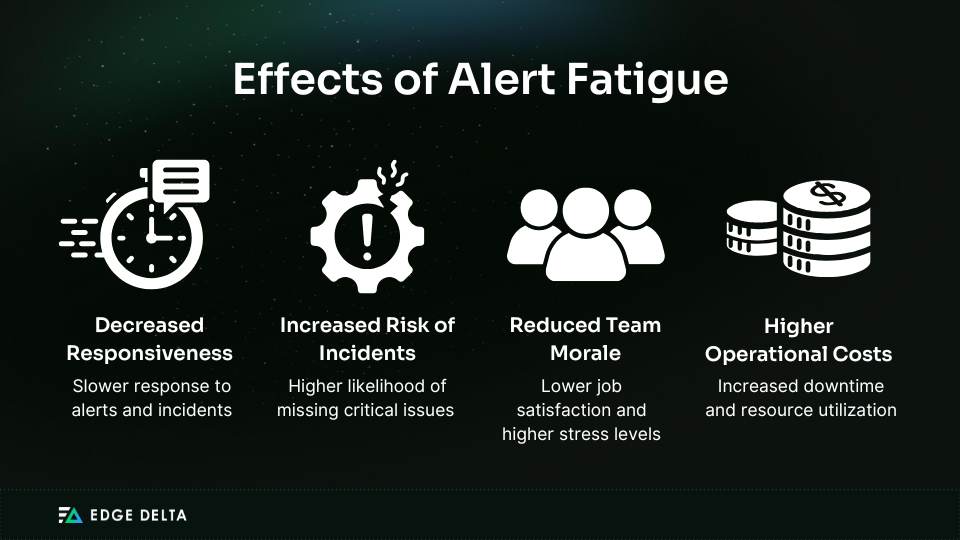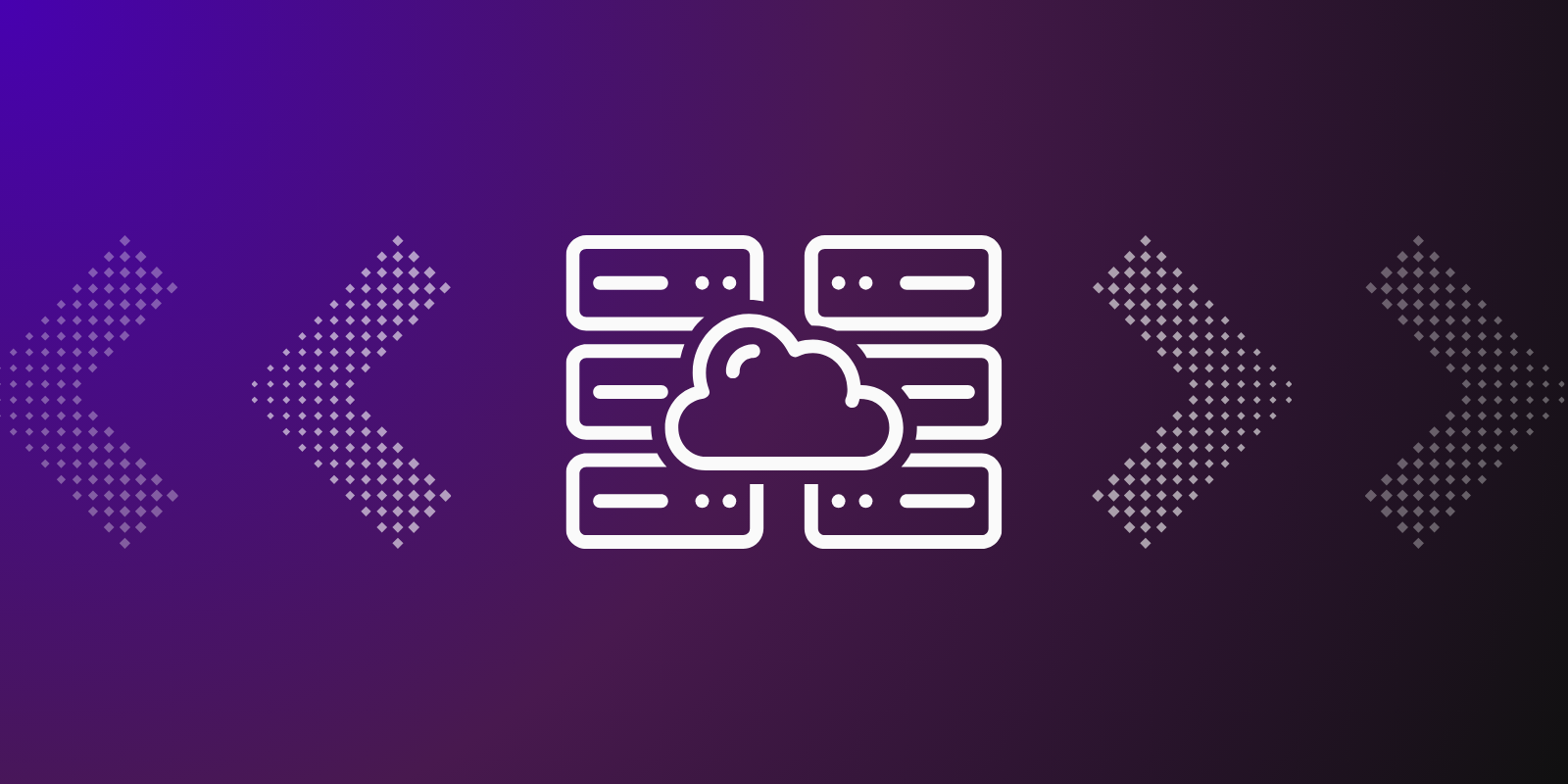Alert fatigue desensitizes systems if left unchecked. Dig deeper into alert fatigue, including its causes, effects, and solutions to improve your monitoring.
Alert fatigue, also known as alarm fatigue, is an issue that occurs when an overwhelming number of alerts desensitizes a monitoring system. It’s a significant issue in IT operations, increasing the likelihood of missing or delaying responses to critical issues. As a result, it leads to more extended and more frequent system downtime and other problems.
Addressing alert fatigue is crucial for organizations as it affects system reliability, team efficiency, and the success of the operations. Too many alerts can overwhelm teams, which can result in service disruptions, employee stress, and lower productivity.
This article discusses the significant impacts of alert fatigue on IT infrastructure, including its causes, effects, and possible solutions. Keep reading to learn more.
Key Takeaways
- Alert fatigue happens when an overwhelming number of alerts desensitize the monitoring system. It’s usually caused by handling multiple unfiltered and excessive alerts that aren’t correctly tuned or are false positives.
- Without meticulous and proper alert prioritization, alerts are handled equally. This issue makes it difficult for DevOps to focus and respond to the most critical issues.
- When IT and DevOps teams are flooded with performance issues alerts, system vulnerabilities become more challenging for them to respond to and manage system infrastructure.
- Alert fatigue increases downtime, prolongs resolution times, and causes improper resource resolution in cybersecurity. As a result, organizations encounter significant financial loss.
- Some methods to mitigate alert fatigue are improving alert quality, refining alert criteria, and regular alert audits.
What Is the Meaning of Alert Fatigue?
Alert fatigue is when a monitoring system handles multiple unfiltered alerts that aren’t correctly tuned or false positives. In IT and cybersecurity, alert fatigue occurs from burnout analytics, leading to a diminished ability to react effectively and investigate threats and attacks.
Cyberattacks are growing more complex and frequent, which is contributing to alert fatigue. A recent alert fatigue statistics by IDC white paper report shows that cybersecurity and IT teams struggle with alert fatigue across businesses of all sizes. It was found that 30% of alerts were not investigated and wholly ignored, significantly impacting the cyber attack.
To better understand the causes of alert fatigue, here’s a table summarizing its causes and description.
| Cause of Alert Fatigue | Description |
| Excessive Alerts | High volume of alerts, including false positives and redundant alerts |
| Lack of Alert Prioritization | No differentiation between critical and non-critical alerts |
| Poorly Defined Alert Criteria | Imprecise or irrelevant alert conditions and criteria |
| Inadequate Alert Management Tools | Outdated or inefficient alert systems |
Excessive Alerts
An excessive number of alerts, including false positives and redundant alerts, can overwhelm DevOp and IT teams. When security professionals become progressively flooded and desensitized to alerts, they may assume they are false positives and ignore them, leading to a false sense of security and more critical issues.
Some of the most common activities or potential threats that cause excessive alert notifications include:
- Login attempts and attempted unauthorized access
- Suspicious network activity, including data breaches and network intrusion
- Detection of software viruses and malware
- False positive alerts
Lack of Alert Prioritization
Alerts have different levels of criticality, including high-priority level and lower-priority security incidents. Without meticulous and proper prioritization, alerts are handled equally, which makes it difficult to focus and respond to the most critical issues.
Poorly Defined Alert Criteria
Poorly defined alert criteria contribute to alert fatigue, generating excessive irrelevant or low-priority alerts. The high volume of irrelevant alerts desensitizes teams, making it difficult to differentiate between essential and trivial alerts. This situation eventually leads to slower responses and missed critical incidents.
Inadequate Alert Management Tools
Inefficient or outdated alert management tools significantly contribute to alert fatigue. That’s why IT teams find it hard to manage and respond to alerts. Modern tools with advanced features like filtering and automation can help reduce alert fatigue.
In the next section, read on and discover the effects of alert fatigue in IT operations.
Effects of Alert Fatigue
Alert fatigue has many detrimental effects on IT operations and overall business performance. When DevOps teams are constantly flooded with alerts, their ability to respond effectively decreases, leading to more incidents and significant revenue, cost, and brand reputation consequences.
Here are the adverse effects of alert fatigue on IT operations and practices:
Decreased Responsiveness
When IT and DevOps teams are bombarded with alerts related to performance issues, system vulnerabilities, and IT-related events, it becomes harder for them to manage and organize system infrastructure.
Additionally, differentiating security-related and operational alerts becomes more challenging, leading to confusion and potential delays in critical security incident response.
Increased Risk of Incidents
Essential alerts are mostly overlooked and unnoticed when there is data fatigue, which causes increasing incidents and puts the company’s security at risk.
Successful malware attacks, for example, will not be detected due to ignored alerts. One alert fatigue example is the aforementioned IDC report, which estimated that over 5,000 employees of cybersecurity teams ignored 23% of their alerts. It led to unnoticed attacks, resulting in problematic system issues.
Reduced Team Morale
When team members are bombarded with alerts, it disrupts their workflow and reduces their ability to focus on significant tasks. Over time, this constant barrage of alerts leads to exhaustion, burnout, and frustration, ultimately affecting the team’s overall productivity and morale.
Higher Operational Costs
When cybersecurity experiences increased downtime, longer resolution times, and higher resource resolution, it increases organization costs and financial loss.
One relevant example is the Equifax data breach in 2017, which cost over $1.4 billion in operational costs. According to reports, the security team failed to act on system vulnerabilities primarily due to alert fatigue and overwhelming notifications.
You must know how to prevent alert fatigue to avoid these effects from impacting your operations.
6 Effective Solutions to Mitigate Alert Fatigue
Alert fatigue can be prevented by mitigating a practical strategic approach that enhances the relevance of alert management and improves team members’ performance.
Here are several solutions to prevent alert fatigue.
| Solution | Description | Mitigation Solution |
| Improving Alert Quality | Reducing false positives and ensuring actionable alerts | Implementing refining criteriaUtilizing machine learning |
| Implementing Alert Prioritization | Categorizing alerts by severity and criticality | Implementing thresholds and a tiered alert system |
| Refining Alert Criteria | Setting precise and meaningful thresholds | Using metrics, reports, and feedbackReviewing and updating alert criteriaExamining the volume of trivial alerts |
| Utilizing Advanced Tools | Using intelligent and automated alert management tools | Utilizing tools with advanced features like automation and filtering. |
| Regular Alert Audits | Conducting frequent reviews to address alert fatigue | Scheduling regular alert system reviewsIdentifying and eliminating “Noise” or repetitive alertsOptimizing alert settings |
| Promoting Continuous Improvement | Encouraging feedback and refining practices | Fostering feedback cultureEncouraging team collaborationsRefining alert processing based on feedback |
Here are in-depth explanations of how can alert fatigue be mitigated.
1. Improving Alert Quality
Since alerts are at the front end of your IT operations pipeline, ensure they are relevant and actionable. Implement strategies like refining criteria for triggering alerts or utilizing machine learning to recognize alert patterns. It’s also critical to standardize what comes in and relate events to each other based on the agreed-upon standard set of attributes.
IT members and DevOps teams should give more focus on genuine threats and use organizations’ specific definitions for these alert quality levels, which include:
- Low-quality alerts: Misconfigured alerts that lack essential information.
- Medium-quality alerts: Meets basic criteria for actionability and provides information for configurational items (CI).
- High-quality alerts: Encompasses comprehensive details and facilitates prompts and effective resolution.
2. Implementing Alert Prioritization
Prioritize alerts based on their severity and criticality. Implement thresholds and a tiered alert system to provide priority levels and ensure that the most urgent and essential alerts receive immediate solutions. In contrast, less critical alerts are managed accordingly.
For illustration, a cybersecurity team can assign different levels based on alert severity. Alert systems can be defined as:
- Level 1: Assigned for critical alerts needing immediate solutions and attention
- Level 2: Assigned for alerts requiring action within a set timeframe
- Level 3: Assigned for low-priority alerts to be addressed during regular working hours
3. Refining Alert Criteria
Refining the alert criteria reduces noise and ensures alerts accurately reflect significant events. The process involves setting precise and meaningful thresholds that can be done by adjusting the sensitivity of alerts.
The refining process can be done using the following methods:
- Using metrics, reports, and feedback to review alerting performance
- Reviewing and updating alert criteria based on operational changes
- Examining the volume of trivial alerts and categorizing which ones are relevant
4. Utilizing Advanced Alert Management Tools
Advanced alert management tools filter irrelevant alerts and help IT and DevOps teams detect, prioritize, and manage alerts. Utilize tools that offer advanced features like machine learning and automation.
Additionally, understand the integrated process so that these advanced alert fatigue software can centralize, prioritize, streamline, and expedite IT alerts and responses and help with the following:
- Mitigating risks
- Minimizing downtime
- Managing notifications
- Speeding up response to alerts
5. Regular Alert Audits
Regular alert audits help evaluate the effectiveness of the organization’s alert system. With frequent audits, you can streamline the response rate as they can determine redundant and necessary alerts, leading to improved and efficient overall performance.
Additionally, regular audits can detect whether alert systems allow DevOps teams to update their alert criteria and threshold based on emerging threats and operational needs.
These regular alert audits can be implemented using these practices:
- Scheduling regular alert system reviews
- Identifying and eliminating “Noise” or repetitive alerts
- Optimizing alert settings and investigating findings
6. Promoting a Culture of Continuous Improvement
Encourage feedback and collaboration to refine alerting practices. This solution can also foster an environment where teams can share insights and suggest improvements. Implementing regular updates and alert checking to enhance the alert management process is crucial. This way, you can meet challenging operational demands and detect potential threats.
Organizations can mitigate solutions and promote a continuous improvement culture through the following:
- Fostering feedback culture
- Encouraging team collaborations
- Refining alert processing based on feedback
- Updating the alert management system regularly
Wrap Up
Alert fatigue poses significant issues in cybersecurity and organizations of all sizes. It arises from increased dependence on digital technology and the inundation of multiple notifications. While its cause is firmly rooted in technology, it affects many high-pressure professions.
By understanding the effects and implementing practical mitigation processes like prioritizing alert management, organizations can reap the benefits of increased efficiency, safety, and reduced burnout and stress, ensuring that alert fatigue does not compromise vital work performance.
FAQs on Alert Fatigue
u003cstrongu003eWhat causes alert fatigue?u003c/strongu003e
Alert fatigue is caused by the unfiltered and overwhelming number of alerts that hinder team members from responding quickly, leaving them missed or ignored.
u003cstrongu003eWhat is alert fatigue in cybersecurity?u003c/strongu003e
It occurs when cybersecurity professionals are inundated with a high volume of security alerts, which hinders the effective handling of issues and relevant security alerts.
u003cstrongu003eWhat is an example of alert fatigue?u003c/strongu003e
For example, someone who receives one alert daily about an anomaly in the factory system will likely pause their work and respond swiftly to deal with it.
u003cstrongu003eWhat is the fatigue warning?u003c/strongu003e
Some of the fatigue warnings are enormous amounts of alerts, unfiltered data, out-of-contact, and undesignated alerts.







